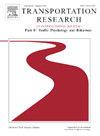Identifying a broad range of psychological characteristics associated with unsafe driving behaviors
IF 3.5
2区 工程技术
Q1 PSYCHOLOGY, APPLIED
Transportation Research Part F-Traffic Psychology and Behaviour
Pub Date : 2024-11-01
DOI:10.1016/j.trf.2024.10.024
引用次数: 0
Abstract
Unsafe driving behaviors (UDBs) represent one of the most consequential classes of behavior in public health. The present study aims to identify a greater range of psychological and behavioral characteristics associated with UDBs, with a special focus on identifying characteristics varying in their associations with different UDBs. Data was analyzed from the Eugene-Springfield Community Study (ESCS) linking self-ratings of the 2539-item International Personality Item Pool (IPIP; Goldberg et al., 2006) to self-reports of four UDBs: speeding, driving after drinking alcohol, driving without a seatbelt, and consuming food or drinks while driving. A subset of 176 IPIP items were identified as having non-trivial relations with the four UDBs, which were then organized into 20 more specific clusters. Some groups were commonly predictive of all four UDBs, such as tendencies to break rules, to view cheating as acceptable, or to talk impulsively. Others were mainly predictive of one UDB but not others. For instance, religiosity was uniquely predictive of lower tendencies to drive after drinking alcohol, whereas negative self-perceptions were uniquely predictive of greater tendencies to drive without a seatbelt. The results provide a more molecular, fine-grained picture of the characteristics associated with UDBs, which can inform larger models of why people engage in UDBs, and why they perform some but not others.
识别与不安全驾驶行为相关的各种心理特征
不安全驾驶行为(UDBs)是公共卫生领域中后果最严重的行为类别之一。本研究旨在确定与不安全驾驶行为相关的更广泛的心理和行为特征,尤其侧重于确定与不同不安全驾驶行为相关的不同特征。研究分析了尤金-斯普林菲尔德社区研究(ESCS)的数据,将 2539 项国际人格项目库(IPIP;Goldberg 等人,2006 年)的自我评分与四种僭越行为的自我报告联系起来,这四种僭越行为是:超速、饮酒后驾驶、不系安全带驾驶以及驾驶时食用食物或饮料。176 个 IPIP 项目中的一个子集被确定为与四种 UDBs 有非同一般的关系,然后将其归纳为 20 个更具体的群组。有些群组通常可以预测所有四种 UDBs,如违反规则的倾向、认为欺骗是可以接受的倾向或说话冲动的倾向。另一些则主要预测一种uedbet体育,而不是其他uedbet体育。例如,宗教信仰对较低的酒后驾车倾向具有独特的预测作用,而消极的自我认知对较高的不系安全带驾车倾向具有独特的预测作用。这些结果提供了与uedbet体育相关的更分子化、更细粒度的特征图谱,可以为人们参与uedbet体育的更大模型提供信息,说明他们为什么会参与uedbet体育,以及他们为什么会进行一些uedbet体育而不是其他uedbet体育。
本文章由计算机程序翻译,如有差异,请以英文原文为准。
求助全文
约1分钟内获得全文
求助全文
来源期刊
CiteScore
7.60
自引率
14.60%
发文量
239
审稿时长
71 days
期刊介绍:
Transportation Research Part F: Traffic Psychology and Behaviour focuses on the behavioural and psychological aspects of traffic and transport. The aim of the journal is to enhance theory development, improve the quality of empirical studies and to stimulate the application of research findings in practice. TRF provides a focus and a means of communication for the considerable amount of research activities that are now being carried out in this field. The journal provides a forum for transportation researchers, psychologists, ergonomists, engineers and policy-makers with an interest in traffic and transport psychology.

 求助内容:
求助内容: 应助结果提醒方式:
应助结果提醒方式:


